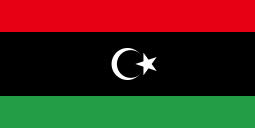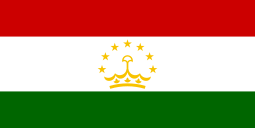Christian population growth
Christian population growth is the population growth of the global Christian community. According to a 2011 Pew Research Center survey, there were 2.3 billion Christians around the world in 2010, more than three times as many as the 600 million recorded it 1910. However, this rate of growth is slower than the overall population growth over the same time period.[1] According to a 2015 Pew Research Center study, by 2050, the Christian population is expected to be 2.9 billion.[2]
The average Christian fertility rate is 2.7 children per woman, which is higher than the global average fertility rate of 2.5. Globally, Christians were only slightly older (median age of 30) than the global median age of 28 in 2010. According to Pew Research religious switching is projected to have a modest impact on changes in the Christian population.[3] According to the World Christian Encyclopedia, approximately 2.7 million convert to Christianity annually from another religion; World Christian Encyclopedia also stated that Christianity ranks in first place in net gains through religious conversion.[4] While, according "The Oxford Handbook of Religious Conversion" between 1990-2000, approximately 1.9 million people converted to Christianity from another religion, with Christianity ranking first in net gains through religious conversion.[5] According to "The Oxford Handbook of Religious Conversion", in mid-2005 approximately 15.5 million convert to Christianity from another religion, approximately 11.7 million leave Christianity, and most of them become irreligious, resulting in a net gain of 3.8 million.[6] Christianity adds about 65.1 million people due to factors such as birth rate and religious conversion, while losing 27.4 million people due to factors such as death rate and religious apostasy in mid-2005. Most of the net growth in the numbers of Christians is in Africa, Latin America and Asia.[6]
Summary
| Tradition | Followers | % of the Christian population | % of the world population | Follower dynamics | Dynamics in- and outside Christianity |
|---|---|---|---|---|---|
| Catholic Church | 1,094,610,000 | 50.1 | 15.9 | ||
| Protestantism | 800,640,000 | 36.7 | 11.6 | ||
| Orthodoxy | 260,380,000 | 11.9 | 3.8 | ||
| Other Christianity | 28,430,000 | 1.3 | 0.4 | ||
| Christianity | 2,184,060,000 | 100 | 31.7 |
The Christian fertility rate is 2.7 children per woman, which is higher than the global average fertility rate of 2.5. Globally, Christians were only slightly older (median age of 30) than the global average median age of 28 in 2010. According to Pew Research religious switching is projected to have a modest impact on changes in the Christian population.[3]
According to the World Christian Encyclopedia, approximately 2.7 million converting to Christianity from another religion, World Christian Encyclopedia also cited that Christianity rank at first place in net gains through religious conversion.[4] While according to "The Oxford Handbook of Religious Conversion", approximately 15.5 million converting to Christianity from another religion, while approximately 11.7 million leave Christianity, and most of them become irreligious, resulting in a net gain of 3.8 million.[6] Christianity earns about 65.1 million people due to factors such as birth rate, the religious conversion while losing 27.4 million people due to factors such as death rate, religious apostasy. Most of the net growth in the numbers of Christians are in Africa, Latin America and Asia.[6]
Fertility rate
The Christian fertility rate has varied throughout history, as with other fertility figures. The Christian fertility rate also varies from country to country. In the 20-year period from 1989–2009, the average world fertility rate decreased from 3.50 to 2.58, a fall of 0.92 children per woman, or 26%. The weighted average fertility rate for Christian nations decreased in the same period from 3.26 to 2.58, a fall of 0.68 children per woman, or 21%. The weighted average fertility rate for Muslim nations decreased in the same period from 5.17 to 3.23, a fall of 1.94 children per woman, or 38%. While Muslims have an average of 3.1 children per woman—the highest rate of all religious groups—Christians are second, with 2.7 children per woman.[2]
The gap in fertility between the Christian- and Muslim-dominated nations fell from 67% in 1990 to 17% in 2010. According to a study published by the Pew Research Center in 2017, births to Muslims between the years of 2010 and 2015 made up an estimated 31% of all babies born around the world. By the Pew Research Center's estimates, the Muslim fertility rate and Christian fertility rate will converge by 2040.[8]
| Country | Fertility rate (2005–2010) (births/woman)[9] | Percent Christian |
|---|---|---|
| 2.58 | 94% | |
| 6.53 | 99% | |
| 1.39 | 98.6% | |
| 5.36 | 92% | |
| 1.40 | 95.3% | |
| 2.55 | 88.0% | |
| 1.33 | 90% |
Conversion
- Pew Research estimates that 40 million people are expected to convert to Christianity between 2010–2050, and 106 million people are expected to leave Christianity during that period (resulting in a net loss of 66 million).[3] This is in contrast to most other religions, including Islam and Hinduism, where the number converting in is roughly similar to the number converting out.[3]
- According to the World Christian Encyclopedia, approximately 2.7 million people convert to Christianity annually from another religion, with Christianity ranking first in net gains through religious conversion.[10]
- According to "The Oxford Handbook of Religious Conversion" between 1990-2000, approximately 1.9 million people converted to Christianity from another religion, with Christianity ranking first in net gains through religious conversion.[5]
- According to "The Oxford Handbook of Religious Conversion", in mid-2005 approximately 15.5 million convert to Christianity annually from another religion, approximately 11.7 million leave Christianity annually, and most of them become irreligious, resulting in a net gain of 3.8 million.[6]
- Studies estimate significantly more people have converted from Islam to Christianity in the 21st century than at any other point in Islamic history.[11] Conversion to Christianity has also been well documented, and reports estimate that hundreds of thousands of Muslims convert to Christianity annually. Significant numbers of Muslim converts to Christianity can be found in Afghanistan, Albania,[12] Azerbaijan,[13][14] Algeria,[15] Belgium,[16] Bulgaria,[17][18] France,[19] Germany,[20] Indonesia,[21] Iran,[22][23][24][25] Kazakhstan,[26] Kyrgyzstan,[27] Malaysia,[28] Morocco,[29][30] Netherlands,[31] Russia,[32] Saudi Arabia,[33] Tunisia,[34] Turkey,[35][36][37][38] Kosovo,[39] The United States[40] and Central Asia etc.[41][42] Many of the Muslims who convert to Christianity face social rejection or imprisonment and sometimes murder or penalty, for becoming Christians.[43]
- Data from the Pew Research Center show that, as of 2013, about 1.6 million adult American Jews identify themselves as Christians; most are Protestant.[44][45][46] According to the same data, most of this group were raised as Jews or are Jews by ancestry.[45] Data from 2013, show that 64,000 Argentine Jews identify themselves as Christians.[47] According to 2012 study 17% of Jews in Russia identify themselves as Christians.[48][49]
- Conversion into Christianity has significantly increased among Korean,[50] Chinese,[51] and Japanese in the United States.[52] In 2012, the percentage of Christians in these communities were 71%, 30% and 37% respectively.[53]
- Due to conversion, the number of Chinese Christians has increased significantly; from 4 million before 1949 to 67 million in 2010.[54][55]
- Due to conversion, Christianity has grown in South Korea, from 2.0% in 1945[56] to 29.3% in 2010.[54]
By branches
Catholic Church
- Church membership in 2007 was 1.147 billion people[57] (17% of the global population at the time), increasing from the 1950 figure of 437 million[58] and 654 million in 1970.[59][60] On 31 December 2008, membership was 1.166 billion, an increase of 11.54% over the same date in 2000,[61][61] and slightly greater than the rate of increase of the world population (10.77%). The increase was 33.02% in Africa,[61] but only 1.17% in Europe. It was 15.91% in Asia, 11.39% in Oceania, and 10.93% in Americas.[61] As a result, Catholics were 17.77% of the total population in Africa, 63.10% in Americas, 3.05% in Asia, 39.97% in Europe, 26.21% in Oceania, and 17.40% of the world population. Of the world's Catholics, the proportion living in Africa grew from 12.44% in 2000 to 14.84% in 2008, while those living in Europe fell from 26.81% to 24.31%. However, Catholic numbers have grown in Scandinavia where the Catholics in Nordic dioceses have tripled or even quadrupled. For example, in Denmark, Norway, Sweden and Finland, 330,000 Catholics have now registered in their dioceses.[62][63] Membership of the Catholic Church is attained through baptism,[64] and from 1983 to 2009, if someone formally left the Church, that fact was noted in the register of the person's baptism.
- Monsignor Vittorio Formenti, who compiles the Vatican's yearbook, said in an interview with the Vatican newspaper L'Osservatore Romano that "For the first time in history, we are no longer at the top: Muslims have overtaken us." He said that Catholics accounted for 17.4 percent of the world population—a stable percentage—while Muslims were at 19.2 percent. "It is true that while Muslim families, as is well known, continue to make a lot of children, Christian ones on the contrary tend to have fewer and fewer," the monsignor said,[65] though Africa and parts of Asia are the exception. If the UN report in 2018 is on target, Africa's population will grow to 4.5 billion by 2100, adding to all African religious groups.[66] Muslims in 2010 represented as much as 23.4% of the total world population and this is expected to increase to 26.3% by 2030.[67] The global Catholic population is projected to grow to 1.63 billion in 2050,[68] but by that time Islam will have nearly 3 billion adherents.
Eastern Orthodoxy
Protestantism
- According to Mark Jürgensmeyer of the University of California, popular Protestantism is one of the most dynamic religious movements in the contemporary world.[69] Changes in worldwide Protestantism over the last century have been significant.[70] Since 1900, due primarily to conversion, Protestantism has spread rapidly in Africa, Asia, Oceania and Latin America.[71]
- There are more than 900 million Protestants worldwide,[1][72][73][74][75][76][77] among approximately 2.4 billion Christians.[72][78][79][80] In 2010, a total of more than 800 million included 300 million in Sub-Saharan Africa, 260 million in the Americas, 140 million in Asia-Pacific region, 100 million in Europe and 2 million in Middle East-North Africa.[1] Protestants account for nearly forty percent of Christians worldwide and more than one tenth of the total human population.[1]
- Protestantism is growing in Africa,[81][82] Asia,[82][83] Latin America,[82][84] Muslim world,[85] and Oceania,[86] while remaining stable or declining in Anglo America[86] and Europe,[75][87] with some exceptions such as France,[88] where it was eradicated after the abolition of the Edict of Nantes by the Edict of Fontainebleau and the following persecution of Huguenots, but now is claimed to be stable in number or even growing slightly.[88] According to some, Russia is another country to see a Protestant revival.[89][90][91]
By country
- According to the Carnegie Endowment for International Peace, the World Christian Database as of 2007 estimated the six fastest-growing religions of the world to be Islam (1.84%), the Bahá'í Faith (1.7%), Sikhism (1.62%), Jainism (1.57%), Hinduism (1.52%) and Christianity (1.32%). High birth rates were cited as the reason for the growths.[92]
- The U.S. Center for World Mission stated a growth rate of Christianity at 2.3% for the period 1970 to 1996 (slightly higher than the world population growth rate at the time). This increased the claimed percentage of adherents of Christianity from 33.7% to 33.9%.[93]
- The World Christian Database as of 2007 estimated the growth rate of Christianity at 1.32%. High birth rates and conversions were cited as the main reasons.[94]
- Using data from the period 2000–2005 the 2006 Christian World Database estimated that by number of new adherents, Christianity was the fastest growing religion in the world with 30,360,000 new adherents in 2006. This was followed by Islam with 23,920,000 and Hinduism with 13,224,000 estimated new adherents in the same period.[95]
- According to 2011 Pew Research Center survey, there are 2.18 billion Christians around the world in 2010, up from about 600 million in 1910.[1]
- According to 2015 Believers in Christ from a Muslim Background: A Global Census study estimates 10,283,700 Muslim converted to Christianity around the world.[85]
- On 2 April 2015, the Pew Research Center published a Demographic Study about "The Future of World Religions: Population Growth Projections, 2010-2050" with projections regarding Christianity.[96] The projection begins with 2010 statistics when "Christianity was by far the world’s largest religion, with an estimated 2.2 billion adherents, nearly a third (31%) of all 6.9 billion people on Earth. Islam was second, with 1.6 billion adherents, or 23% of the global population."[96]
- Projected growth of Christianity by 2050
- Some of the projections are as follows:[97]
- Over the 2010-2050 period, Christians will remain the largest religious group with 30.7% of the world’s population. However, Islam will grow faster and become 29.7% of the world’s population. Therefore, by 2050 there will be 2.8 billion Muslims compared to 2.9 billion Christians.
- “In the United States, Christians will decline from more than three-quarters of the population in 2010 to two-thirds in 2050.”
- “Four out of every 10 Christians in the world will live in sub-Saharan Africa.”
- Reasons given for the projected growth
- Some of the reasons the Study gives are as follows:[96]
- The change in the world’s religious is "driven primarily by differences in fertility rates and the size of youth populations among the world’s major religions, as well as by people switching faiths."
- Fertility rates. "Religions with many adherents in developing countries, where birth rates are high, and infant mortality rates generally have been falling, are likely to grow quickly." Therefore, much of the growth of Christianity is projected to take place in sub-Saharan Africa. Globally, Christians have a birth rate of 2.7 children per woman. But Muslims have a higher rate, namely, an average of 3.1 children per woman. This differential is one of the reasons that the Muslim population is growing faster than the Christian.
- Size of youth population. "In 2010, more than a quarter of the world’s total population (27%) was under the age of 15." Christian youth under 15 were the same as the 27% global average. But an even higher percentage of Muslims (34%) were younger than 15. This higher youth population is one of the reasons that from 2010-2050 Muslims are projected to grow faster than Christians.
- Size of old population. In 2010, "11% of the world’s population was at least 60 years old," 14% of the Christian population was over 60 years old, but only 7% of Muslims were over 60. This is another reason that Muslims are projected to grow faster than Christians.
- Switching. A loss of 66 million Christians is projected to come through switching. Most of the loss is projected to come from Christians "joining the ranks of the religiously unaffiliated."
- The whole Pew Research Center can be read by clicking The Future of World Religions.
Africa
- Christianity has been estimated[1] to be growing rapidly in South America, Africa, and Asia.[80] In Africa, for instance, in 1900, there were only 8.7 million[1] adherents of Christianity; now there are 390 million,[1] and it is expected that by 2025 there will be 600 million Christians in Africa.[1] The number of Catholics in Africa has increased from one million in 1902 to 329,882,000.[1] From 2015 to 2016 alone, Africa saw an increase of 49,767,000 Catholics, a larger increase than any other continent.[98] There are now 1.5 million churches whose congregations account for 46 million people.
- A 2015 study estimates 2,161,000 Muslim Africans that convert to Christianity.[85]

- A 2015 study estimates 200,000 Muslims converted to Christianity in Burkina Faso.[85]

- A 2015 study estimates 1,500 Muslims converted to Christianity in Central African Republic.[85]

- A 2015 study estimates some 14,000 Muslims who converted to Christianity in Egypt.[101]

- A 2015 study estimated some 1,500 believers in Christ from a Muslim background living in the country.[102]

- On 27 March 2010, the Moroccan magazine TelQuel stated that thousands of Moroccans had converted to Christianity. Pointing out the absence of official data, Service de presse Common Ground cites unspecified sources that stated that about 5,000 Moroccans became Christians between 2005 and 2010.[103] According to the International Religious Freedom Report for 2014 estimate that there may be as many as 8,000 Christian citizens throughout the country, but many reportedly do not meet regularly due to fear of government surveillance and social persecution.[104]
- According to different estimates, there are about 25,000-45,000 Moroccan Christians of Berber or Arab descent mostly converted from Islam.[105] Other sources give a number of a bit more than 1,000.[106] A popular Christian program by Brother Rachid has led many former Muslims in North Africa and the Middle East to convert to Christianity. His programs have been credited with assisting in the conversion of over 150,000 former Muslims to Christianity in Morocco.[107]

- In South Africa, Pentecostalism has grown from 0.2% in 1951 to 7.6% in 2001.[109]

- International Religious Freedom Report for 2007 estimate thousands of Tunisian Muslims who convert to Christianity.[34]
Asia

- The United States Department of State estimated the numbers of the Muslim Afghan who convert to Christianity between 500–8,000.[110]

- According to reports there is about 5,000 ethnic Azerbaijani Protestant community most of them came from Muslim backgrounds.[13][14]

- A 2015 study estimates some 130,000 Christians from a Muslim background residing in the Bangladesh, though not all are necessarily citizens.[27]

- In recent years, the number of Chinese Christians has increased significantly, particularly since the easing of restrictions on religious activity during economic reforms in the late 1970s; Christians were 4 million before 1949 (including Catholics and Protestants), and reaching 67 million (unofficial figure) in 2010.[1][55] Various statistical analyses have found that between 2% and 4% of the Chinese identify as Christian.
- The government declared in 2018 that there are over 44 million Christians (Protestant: 38M, Catholic: 6M) in China.[111]
- Reverend Stephen Tong claims that in 2018 there are more than 110 million Christians (Protestants and Catholics) in China.[112]
- Christianity is reportedly the fastest growing religion in China with average annual rate of 7%.[113]

- Christianity is the third largest religion in India after Hinduism and Islam, with approximately 20 million followers.
- A 2015 study estimates some 40,000 Christian believers from a Muslim background in the country, most of them belonging to some form of Protestantism or Catholicism.[114]

- According to the World Christian Encyclopedia, between 1965-1985 about 2.5 million Indonesian converted from Islam to Christianity.[115]
- According to Believers in Christ from a Muslim Background: A Global Census study found that between 1960-2015 about 6.5 million Indonesian Muslims convert to Christianity.[85]
- Some reports also show that many of the Chinese Indonesians minority convert to Christianity.[116][117] Demographer Aris Ananta reported in 2008 that "anecdotal evidence suggests that more Buddhist Chinese have become Christians as they increased their standards of education".[118]

- Several thousand Israelis practice Messianic Jewish denominations, which are often considered as Christian sects. The Messianic Jews usually combine Jewish and Christian practices but do recognize Jesus as the Messiah. There are no exact numbers on those communities, but it is believed that several hundred to several thousand ethnic Jews belong to this tradition as well as several thousand Israelis of mixed ancestry (mostly mixed Jewish and Slavic).
- The Christian population in Israel has increased significantly with the immigration of many mixed families from the former Soviet Union (1989-late 1990s).
- A 2015 study estimates some 300 Christians from a Muslim background in Israel.

- A 2015 study estimates some 6,500 Christian believers from a Muslim background in the country, most of them belonging to some form of Eastern Orthodoxy.[124]

- In spite of the persecution of converts from Islam to Christianity, a 2015 study estimates some 50,000 believers in Christ from a Muslim background residing in the country.[102]

- There are a number of believers in Christ from a Muslim background in the country, though many are not citizens. A 2015 study estimates that around 350 people in the country follow these beliefs.[125]

- A 2015 study estimates some 19,000 Christians from a Muslim background residing in the country, though not all are necessarily citizens of Kyrgyzstan.[102]

- According to a Hindu organization, 130,000 people converted from Hinduism to Christianity between 1965 and 1990. Around 97,000 joined the Methodist Church and the rest mostly joined various Protestant denominations, with 2,500 joining the Catholic Church.[126]
- There is no well researched agreement on the actual number of Malaysian Muslim converts to Christianity in Malaysia.[28] But according to Tan Sri Dr Harussani Zakaria, they are 260,000.[28]

- According to the Christian missionary group Barnabas Fund, the number of Christians in Mongolia grew from just four in 1989 to around 40,000 as of 2008.[127]

- A 2015 study estimates a mere 200 believers in Christ from a Muslim background in the country, and not all of those are necessarily citizens[128]

A 2015 study estimates 60,000 Muslims converted to Christianity in Saudi Arabia.[85]

- The percentage of Christians among Singaporeans increased from 12.7% in 1990 to 17.5% in 2010.[129]

- In South Korea, Christianity has grown from 20.7% in 1985 to 29.5% in 2005 according to the World Christian Database.[109][130]

- A 2015 study estimates some 2,000 Muslims who converted to Christianity in Syria, most of them belonging to some form of Protestantism or Oriental Orthodoxy.[124]

- In spite of opposition in relation to conversion from Islam to Christianity, a 2015 study estimates some 2,600 Christians with Muslim backgrounds reside in the country.[131]

- According to the newspaper, "Milliyet" reports 35,000 Muslim Turks convert into Christianity in 2008.[132] A 2015 study estimates some 4,500 believers in Christ from a Muslim background in Turkey, most of them Turks.[133] The ethnic Turkish Protestant Christian community in Turkey number about 4,000-5,000[134] adherents most of them came from Muslim Turkish background.[135][136][137][138]

- A 2015 study estimates some 10,000 believers in Christ from a Muslim background in the country, most of them belonging to some sort of evangelical or charismatic Protestant community.[131]

- The US Department of State estimates that Protestant Christianity may have grown 600% over the last decade in Vietnam.[139]
Europe

- A 2015 study estimated some 13,000 followers of Christ from a Muslim background, though it is not clear to which Christian churches these people had converted.[140]

- Reports estimated that thousands of Muslims (mostly Bulgarian Turks) convert every year to Christianity in Bulgaria.[17][18] A 2015 study estimates 45,000 Christian believers from a Muslim background in the country, most of them belonging to some form of Protestantism.[114]

- There are around 8,000 Christians who have converted from a Muslim background in the country, most of them belonging to some form of Protestantism.[141]

- It is estimated that Orthodoxy is the fastest-growing religious faith in Norway, due to immigration from other countries, with a growth rate from 2000 to 2009 at 231.1%.[144]

- Reports estimated that 4,500 Muslims have converted to Christianity in the Netherlands.[31]

- According to Roman Silantyev the executive secretary of the Inter-religious Council in Russia, about 2 million Muslims in Russia have converted to Christianity between during the last fifteen years while only 2,500 Russians converted to Islam.[32]
- According to a 2012 study, 17% of Jews in Russia identify themselves as Christians.[48][49]

- In recent years a number of Swedish Muslims have converted from Islam to the Church of Sweden, most noticeably by Iranians, but also by Arabs and Pakistanis.[145]

- A 2015 study estimated some 25,000 believers in Christ from a Muslim background, most of whom belong to an evangelical or Pentecostal community.[146]
Americas

A 2015 study estimates some 2,200 Christian believers from a Muslim background in the country, most of them belonging to some form of Protestantism.[124]
Data from 2013, show that 64,000 Argentine Jews identify themselves as Christians.[147]
.svg.png)
According to 1991/2001/2011-Census, the number of Christians in Canada has decreased from 22.5 million to 22.1 million.
A 2015 study estimates some 43,000 believers in Christ from a Muslim background in Canada, most of whom belong to the evangelical tradition. [148]

According to INEGI, The number of Catholics grows annually by 1.7%.[149]

The United States government does not collect religious data in its census. The survey below, the American Religious Identification Survey (ARIS) 2008, was a random digit-dialed telephone survey of 54,461 American residential households in the contiguous United States. The 1990 sample size was 113,723; 2001 sample size was 50,281.
Adult respondents were asked the open-ended question, "What is your religion, if any?" Interviewers did not prompt or offer a suggested list of potential answers. The religion of the spouse or partner was also asked. If the initial answer was "Protestant" or "Christian" further questions were asked to probe which particular denomination. About one-third of the sample was asked more detailed demographic questions.
Among the Asian population in the United States, conversion into Christianity is significantly increasing among Korean, Chinese, and Japanese.[150] By 2012 the percentage of Christians in these communities was 71%, 31%, and 38% respectively.[53]
Data from the Pew Research Center states that, as of 2013, about 1.6 million adult American Jews identify themselves as Christians, most as Protestants.[44][45][46] According to the same data, most of the Jews who identify themselves as some sort of Christian (1.6 million) were raised as Jew or are Jews by ancestry.[45]
According to Pew Research, Christianity loses more people than it gains from religious conversion. It found that 23% of Americans raised as Christians no longer identified with Christianity, whereas 6% of current Christians converted.[151] This was in contrast to Islam in America, where the number of people who leave the religion is roughly equal to the number who convert to it.[151] The National Catholic Register claims that in 2015 there were 450,000 American Muslim converts to Christianity and that 20,000 Muslims convert to Christianity annually in the United States.[152]
Religious Self-Identification of the U.S. Adult Population: 1990, 2001, 2008[153]
Figures are not adjusted for refusals to reply; investigators suspect refusals are possibly more representative of "no religion" than any other group.
| Group | 1990 adults x 1,000 | 2001 adults x 1,000 | 2008 adults x 1,000 | Numerical Change 1990– 2008 as % of 1990 | 1990 % of adults | 2001 % of adults | 2008 % of adults | change in % of total adults 1990– 2008 |
|---|---|---|---|---|---|---|---|---|
| Adult population, total | 175,440 | 207,983 | 228,182 | 30.1% | ||||
| Adult population, Responded | 171,409 | 196,683 | 216,367 | 26.2% | 97.7% | 94.6% | 94.8% | −2.9% |
| Total Christian | 151,225 | 159,514 | 173,402 | 14.7% | 86.2% | 76.7% | 76.0% | −10.2% |
| Catholic | 46,004 | 50,873 | 57,199 | 24.3% | 26.2% | 24.5% | 25.1% | −1.2% |
| non-Catholic Christian | 105,221 | 108,641 | 116,203 | 10.4% | 60.0% | 52.2% | 50.9% | −9.0% |
| Baptist | 33,964 | 33,820 | 36,148 | 6.4% | 19.4% | 16.3% | 15.8% | −3.5% |
| Mainline Christian | 32,784 | 35,788 | 29,375 | −10.4% | 18.7% | 17.2% | 12.9% | −5.8% |
| Methodist | 14,174 | 14,039 | 11,366 | −19.8% | 8.1% | 6.8% | 5.0% | −3.1% |
| Lutheran | 9,110 | 9,580 | 8,674 | −4.8% | 5.2% | 4.6% | 3.8% | −1.4% |
| Presbyterian | 4,985 | 5,596 | 4,723 | −5.3% | 2.8% | 2.7% | 2.1% | −0.8% |
| Episcopalian/Anglican | 3,043 | 3,451 | 2,405 | −21.0% | 1.7% | 1.7% | 1.1% | −0.7% |
| United Church of Christ | 438 | 1,378 | 736 | 68.0% | 0.2% | 0.7% | 0.3% | 0.1% |
| Christian Generic | 25,980 | 22,546 | 32,441 | 24.9% | 14.8% | 10.8% | 14.2% | −0.6% |
| Christian Unspecified | 8,073 | 14,190 | 16,384 | 102.9% | 4.6% | 6.8% | 7.2% | 2.6% |
| Non-denominational Christian | 194 | 2,489 | 8,032 | 4040.2% | 0.1% | 1.2% | 3.5% | 3.4% |
| Protestant – Unspecified | 17,214 | 4,647 | 5,187 | −69.9% | 9.8% | 2.2% | 2.3% | −7.5% |
| Evangelical/Born Again | 546 | 1,088 | 2,154 | 294.5% | 0.3% | 0.5% | 0.9% | 0.6% |
| Pentecostal/Charismatic | 5,647 | 7,831 | 7,948 | 40.7% | 3.2% | 3.8% | 3.5% | 0.3% |
| Pentecostal – Unspecified | 3,116 | 4,407 | 5,416 | 73.8% | 1.8% | 2.1% | 2.4% | 0.6% |
| Assemblies of God | 617 | 1,105 | 810 | 31.3% | 0.4% | 0.5% | 0.4% | 0.0% |
| Church of God | 590 | 943 | 663 | 12.4% | 0.3% | 0.5% | 0.3% | 0.0% |
| Other Protestant Denominations | 4,630 | 5,949 | 7,131 | 54.0% | 2.6% | 2.9% | 3.1% | 0.5% |
| Churches of Christ | 1,769 | 2,593 | 1,921 | 8.6% | 1.0% | 1.2% | 0.8% | −0.2% |
| Seventh-Day Adventist | 668 | 724 | 938 | 40.4% | 0.4% | 0.3% | 0.4% | 0.0% |
| Jehovah's Witnesses | 1,381 | 1,331 | 1,914 | 38.6% | 0.8% | 0.6% | 0.8% | 0.1% |
| Mormon/Latter Day Saints | 2,487 | 2,697 | 3,158 | 27.0% | 1.4% | 1.3% | 1.4% | 0.0% |
| Total non-Christian religions | 5,853 | 7,740 | 8,796 | 50.3% | 3.3% | 3.7% | 3.9% | 0.5% |
| Jewish | 3,137 | 2,837 | 2,680 | −14.6% | 1.8% | 1.4% | 1.2% | −0.6% |
| Eastern Religions | 687 | 2,020 | 1,961 | 185.4% | 0.4% | 1.0% | 0.9% | 0.5% |
| Buddhist | 404 | 1,082 | 1,189 | 194.3% | 0.2% | 0.5% | 0.5% | 0.3% |
| Muslim | 527 | 1,104 | 1,349 | 156.0% | 0.3% | 0.5% | 0.6% | 0.3% |
| New Religious Movements & Others | 1,296 | 1,770 | 2,804 | 116.4% | 0.7% | 0.9% | 1.2% | 0.5% |
| None/ No religion, total | 14,331 | 29,481 | 34,169 | 138.4% | 8.2% | 14.2% | 15.0% | 6.8% |
| Agnostic+Atheist | 1,186 | 1,893 | 3,606 | 204.0% | 0.7% | 0.9% | 1.6% | 0.9% |
| Did Not Know/ Refused to reply | 4,031 | 11,300 | 11,815 | 193.1% | 2.3% | 5.4% | 5.2% | 2.9% |
Highlights:[153]
- The ARIS 2008 survey was carried out from February–November 2008 and collected answers from 54,461 respondents who were questioned in English or Spanish.
- The American population self-identifies as predominantly Christian but Americans are slowly becoming less Christian.
- 86% of American adults identified as Christians in 1990 and 76% in 2008.
- The historic Mainline churches and denominations have experienced the steepest declines while the non-denominational Christian identity has been trending upward particularly since 2001.
- The challenge to Christianity in the United States does not come from other religions but rather from a rejection of all forms of organized religion.
- 34% of American adults considered themselves "Born Again or Evangelical Christians" in 2008.
- The U.S. population continues to show signs of becoming less religious, with one out of every seven Americans failing to indicate a religious identity in 2008.
- The "Nones" (no stated religious preference, atheist, or agnostic) continue to grow, though at a much slower pace than in the 1990s, from 8.2% in 1990 to 14.1% in 2001, to 15.0% in 2008.
- Asian Americans are substantially more likely to indicate no religious identity than other racial or ethnic groups.
- One sign of the lack of attachment of Americans to religion is that 27% do not expect a religious funeral at their death.
- Based on their stated beliefs rather than their religious identification in 2008, 70% of Americans believe in a personal God, roughly 12% of Americans are atheist (no God) or agnostic (unknowable or unsure), and another 12% are deistic (a higher power but no personal God).
- America's religious geography has been transformed since 1990. Religious switching along with Hispanic immigration has significantly changed the religious profile of some states and regions. Between 1990 and 2008, the Catholic population proportion of the New England states fell from 50% to 36% and in New York it fell from 44% to 37%, while it rose in California from 29% to 37% and in Texas from 23% to 32%.
- Overall the 1990–2008 ARIS time series shows that changes in religious self-identification in the first decade of the 21st century have been moderate in comparison to the 1990s, which was a period of significant shifts in the religious composition of the United States
Oceania
.svg.png)
A 2015 study estimates some 20,000 Muslim converted to Christianity in Australia, most of them belonging to some form of Protestantism.[124]
See also
- Muslim population growth
- Claims to be the fastest-growing religion
- Christian views on contraception
- Christian mission
- Christianity by country
- Christian emigration
References
- "Pewforum: Christianity (2010)" (PDF). Archived from the original (PDF) on 9 September 2013. Retrieved 2 May 2020.
- "The Future of World Religions: Population Growth Projections, 2010-2050" (PDF). Archived from the original (PDF) on 29 April 2015. Retrieved 6 June 2016.
- "The Future of World Religions: Population Growth Projections, 2010-2050".
- David B. Barrett; George Thomas Kurian; Todd M. Johnson, eds. (15 February 2001). World Christian Encyclopedia p.360. Oxford University Press USA. ISBN 0195079639.
- Lewis Ray Rambo; Charles E. Farhadian, eds. (2014). The Oxford Handbook of Religious Conversion p.58. Oxford University Press. ISBN 9780195338522.
- Lewis Ray Rambo; Charles E. Farhadian, eds. (2014). The Oxford Handbook of Religious Conversion p.59. Oxford University Press. ISBN 9780195338522.
- "Global Christianity – A Report on the Size and Distribution of the World's Christian Population". 19 December 2011.
- "The Changing Global Religious Landscape". Pew Research Center's Religion & Public Life Project. 5 April 2017. Retrieved 23 April 2020.
- United Nations Department of Economic and Social Affairs, Population Division (2007). "United Nations World Population Prospects: 2006 revision, Table A.15" (PDF). New York: UN. Retrieved 7 December 2009.CS1 maint: uses authors parameter (link)
- David B. Barrett; George Thomas Kurian; Todd M. Johnson, eds. (15 February 2001). World Christian Encyclopedia p.360. Oxford University Press USA. ISBN 0195079639.
- Garrison, David; 2014; "A Wind In The House Of Islam: How God Is Drawing Muslims Around The World To Faith In Jesus Christ"; WIGTake Resources
- Albanian Government. "L'Albania oggi" (in Italian). Ministry of Foreign Affairs of Albania. Archived from the original on 10 May 2008. Retrieved 30 August 2010.
- "5,000 Azerbaijanis adopted Christianity" (in Russian). Day.az. 7 July 2007. Retrieved 30 January 2012.
- "Christian Missionaries Becoming Active in Azerbaijan" (in Azerbaijani). Tehran Radio. 19 June 2011. Archived from the original on 19 February 2014. Retrieved 12 August 2012.
- Algeria: Situation of Christians, including the treatment of Christians by society and by the authorities
- In Europe, many Muslims renounce Islam, embrace Christianity: Report
- "Structure of the population by confession". NSI. Archived from the original on 25 December 2009. Retrieved 6 June 2016.
- "Ethnic minority communities". NSI. Archived from the original on 24 August 2017. Retrieved 6 June 2016.
- France: Muslims convert to Christianity
- 'Our second mother': Iran's converted Christians find sanctuary in Germany
- History of Christianity in Indonesia. pp. 527-569
- Miller, Duane Alexander (October 2009). "The Conversion Narrative of Samira: From Shi'a Islam to Mary, her Church, and her Son" (PDF). St Francis Magazine. 5 (5): 81–92. Archived from the original (PDF) on 29 October 2013. Retrieved 6 June 2016.
- Miller, Duane Alexander (April 2012). "The Secret World of God: Aesthetics, Relationships, and the Conversion of 'Frances' from Shi'a Islam to Christianity" (PDF). Global Missiology. 9 (3).
- Nasser, David (2009). Jumping through Fires. Grand Rapids: Baker.
- Rabiipour, Saiid (2009). Farewell to Islam. Xulon.
- "Нац состав.rar". Archived from the original on 23 July 2011. Retrieved 24 July 2011.
- Johnstone, Patrick; Miller, Duane Alexander (2015). "Believers in Christ from a Muslim Background: A Global Census". IJRR. 11 (10): 1–19. Retrieved 30 October 2015.
- AHMAD FAROUK MUSA; MOHD RADZIQ JALALUDDIN; AHMAD FUAD RAHMAT; EDRY FAIZAL EDDY YUSUF (22 October 2011). "What is Himpun about?". The Star. Retrieved 16 December 2011.
- Christian Converts in Morocco Fear Fatwa Calling for Their Execution
- House-Churches' and Silent Masses —The Converted Christians of Morocco Are Praying in Secret
- Netherlands: Muslim converts to Christianity live in fear
- 2 million ethnic Muslims adopted baptism in Russia while only 2,5 thousand Russians converted to Islam - expert
- Cookson, Catharine (2003). Encyclopedia of religious freedom. Taylor & Francis. p. 207. ISBN 0-415-94181-4.
- International Religious Freedom Report 2007: Tunisia. United States Bureau of Democracy, Human Rights and Labor (14 September 2007). This article incorporates text from this source, which is in the public domain.
- "TURKEY - Christians in eastern Turkey worried despite church opening". Retrieved 18 March 2015.
- "Turkish Protestants still face "long path" to religious freedom - The Christian Century". The Christian Century. Retrieved 18 March 2015.
- "TURKEY: Protestant church closed down - Church In Chains - Ireland :: An Irish voice for suffering, persecuted Christians Worldwide". Retrieved 18 March 2015.
- khadijabibi (30 October 2009). "35,000 Muslims convert into Christianity each year in Turkey". Chowk.com. Archived from the original on 24 September 2012. Retrieved 19 November 2010.
- Christians in Kosovo Conversion rate
- "America's Changing Religious Landscape". Pew Research Center: Religion & Public Life. 12 May 2015.
- Jeni Mitchell. "FREEradicals – Targeting Christians in Central Asia". Icsr.info. Archived from the original on 24 February 2012. Retrieved 17 August 2012.
- "Despite Government Set-backs, Christianity Is Alive in Central Asia". Opendoorsusa.org. 30 November 2011. Archived from the original on 10 January 2012. Retrieved 17 August 2012.
- How When Muslims become Christians.
- "How many Jews are there in the United States?". Pew Research Center.
- "A PORTRAIT OF JEWISH AMERICANS: Chapter 1: Population Estimates". Pew Research Center.
- "American-Jewish Population Rises to 6.8 Million". haaretz.
- World Jewish Population, 2013
- Arena - Atlas of Religions and Nationalities in Russia. Sreda.org
- 2012 Survey Maps. "Ogonek", № 34 (5243), 27/08/2012. Retrieved 24-09-2012.
- Yoo, David; Ruth H. Chung (2008). Religion and spirituality in Korean America. University of Illinois Press. ISBN 978-0-252-07474-5.
- Leave China, Study in America, Find Jesus | Foreign Policy
- Brian Niiya (1993). Japanese American History: An A-To-Z Reference from 1868 to the Present. VNR AG. p. 28.
- "Japanese Americans - Pew Forum on Religion & Public Life". Archived from the original on 4 March 2016. Retrieved 17 March 2015.
- "Global Christianity: Regional Distribution of Christians". Pew Research Center. 19 December 2011. Retrieved 11 August 2013.
- Miller, 2006. pp. 185-186
- Korean Overseas Information Service, A Handbook of Korea (1993) p, 132
- "Vatican: Priest numbers show steady, moderate increase". Catholic News Service. 2 March 2009. Retrieved 9 March 2008.
- Froehle, pp. 4–5
- Bazar, Emily (16 April 2008). "Immigrants Make Pilgrimage to Pope". USA Today. Retrieved 3 May 2008.
- Bazar, Emily (16 April 2008). "Immigrants Make Pilgrimage to Pope". USA Today. Retrieved 3 May 2008.
- "World's Catholic population steady". Catholic Culture.org. 13 May 2013. Retrieved 13 May 2013.
- "Catholic numbers grow in Scandinavia," THE TABLET, 20 September 2014, 31.
- "Number of Catholics on the Rise". Zenit News Agency. 27 April 2010. Archived from the original on 27 July 2010. Retrieved 2 May 2010.. For greater details on numbers of Catholics and priests and their distribution by continent and for changes between 2000 and 2008, see "Annuario Statistico della Chiesa dell'anno 2008". Holy See Press Office. 27 April 2010. Retrieved 2 May 2010. (in Italian)
- Code of Canon Law, canon 11. Archived 13 August 2010 at the Wayback Machine Retrieved 9 March 2008
- "– Vatican: Islam Surpasses Roman Catholicism as World's Largest Religion – International News | News of the World | Middle East News | Europe News". Foxnews.com. 30 March 2008. Archived from the original on 18 September 2009. Retrieved 1 April 2010.
- Ross Douthat, "Fear of a Black Continent," NEW YORK TIMES, 21 Oct. 2018, 9.
- "The Future of the Global Muslim Population". Pew Research Center's Religion & Public Life Project. 27 January 2011.
- Todd M. Johnson, Gina A. Zurlo, Albert W. Hickman, and Peter F. Grossing, "Christianity 2016: Latin America and Projecting Religions to 2050," INTERNATIONAL BULLETIN OF MISSION RESEARCH, 2016, Vol. 40 (1), 22-29.
- Religion in Global Civil Society by Santa Barbara Mark Juergensmeyer Professor of Sociology and Director of the Global and International Studies Program University of California
- Hillerbrand, Hans J., "Encyclopedia of Protestantism: 4-volume Set", p. 1815, "Observers carefully comparing all these figures in the total context will have observed the even more startling finding that for the first itime ever in the history of Protestantism, Wider Protestants will by 2050 have become almost exactly as numerous as Roman Catholics - each with just over 1.5 billion followers, or 17 percent of the world, with Protestants growing considerably faster than Catholics each year."
- Encyclopedia of Protestantism
- "Christianity 2015: Religious Diversity and Personal Contact" (PDF). gordonconwell.edu. January 2015. Archived from the original (PDF) on 25 May 2017. Retrieved 29 May 2015.
- Encyclopedia of Protestantism. Retrieved 14 February 2015.
- "CCC - Global Statistics". Archived from the original on 22 September 2015. Retrieved 23 April 2015.
- The World's Religions. Retrieved 14 February 2015.
- Protestantism. Retrieved 14 February 2015.
- Protestantism: A Very Short Introduction. Retrieved 14 February 2015.
- 33.39% of 7.174 billion world population (under the section "People and Society") "World". CIA world facts.
- "Major Religions Ranked by Size". Adherents.com. Retrieved 5 May 2009.
- ANALYSIS (19 December 2011). "Global Christianity". Pewforum.org. Retrieved 17 August 2012.
- "Study: Christianity growth soars in Africa – USATODAY.com". USATODAY.COM. 20 December 2011. Retrieved 14 February 2015.
- Ostling, Richard N. (24 June 2001). "The Battle for Latin America's Soul". TIME.com. Retrieved 14 February 2015.
- "In China, Protestantism's Simplicity Yields More Converts Than Catholicism". International Business Times. 28 March 2012. Retrieved 14 February 2015.
- Chris Arsenault. "Evangelicals rise in Latin America". Retrieved 14 February 2015.
- Believers in Christ from a Muslim Background: A Global Census
- The Teachings of Modern Protestantism on Law, Politics, and Human Nature. Retrieved 14 February 2015.
- Religion in a Secularizing Society. Retrieved 14 February 2015.
- Religious Newcomers and the Nation State. Retrieved 14 February 2015.
- "Moscow Church Spearheads Russia Revival". Retrieved 14 February 2015.
- Protestantism in Postsoviet Russia: An Unacknowledged Triumph
- Felix Corley; Geraldine Fagan. "Growing Protestants, Catholics Draw Ire". ChristianityToday.com. Retrieved 14 February 2015.
- Staff (May 2007). "The List: The World's Fastest-Growing Religions". Foreign Policy. Carnegie Endowment for International Peace.
- "GROWTH RATE OF CHRISTIANITY & ISLAM Which will be the dominant religion in the future?".
- "The List: The World's Fastest-Growing Religions". Foreign Policy. Carnegie Endowment for International Peace. May 2007.
- "What is the fastest growing religion in the world? A Secularist Evaluation". FastestGrowingReligion.tk. 2008. Retrieved 12 September 2008.
- World Religions Population Growth Projections, 2010-2050 (2015). Retrieved 18 September 2016.
- World Religions Population :Growth Projections, 2010-2050 (2015). Retrieved 18 September 2016.
- Fides, Agenzia. "VATICAN - CATHOLIC CHURCH STATISTICS 2018 - Agenzia Fides". www.fides.org. Retrieved 8 February 2019.
- "Echorouk Online - A postal executive in Tlemcen province under security investigation into the shady circumstances surrounding his decision to embrace Christianity". Archived from the original on 24 July 2011. Retrieved 3 January 2011.
- Johnstone, Patrick; Miller, Duane Alexander (2015). "Believers in Christ from a Muslim Background: A Global Census". Interdisciplinary Journal of Research on Religion. 11: 14. Retrieved 20 October 2015.
- Johnstone, Patrick; Miller, Duane Alexander (2015). "Believers in Christ from a Muslim Background: A Global Census". IJRR. 11 (10): 1–19. Retrieved 30 October 2015.
- Morocco: General situation of Muslims who converted to Christianity, and specifically those who converted to Catholicism; their treatment by Islamists and the authorities, including state protection (2008-2011)
- "International Religious Freedom Report for 2011 – Morocco". Bureau of Democracy, Human Rights, and Labor.
- "'House-Churches' and Silent Masses —The Converted Christians of Morocco Are Praying in Secret – VICE News".
- Maroc: La conversion de musulmans au christianisme soulève la colère dans le pays
- Osservatorio Internazionale: "La tentazione di Cristo" April 2010
- Johnstone, Patrick; Miller, Duane Alexander (2015). "Believers in Christ from a Muslim Background: A Global Census". IJRR. 11: 14. Retrieved 20 November 2015.
- Religious Demographic Profiles – Pew Forum Archived 21 April 2010 at the Wayback Machine
- USSD Bureau of Democracy, Human Rights, and Labor (2009). "International Religious Freedom Report 2009". Archived from the original on 30 November 2009. Retrieved 6 March 2010.CS1 maint: uses authors parameter (link)
- "《中国保障宗教信仰自由的政策和实践》白皮书(全文)". 3 April 2018. Archived from the original on 8 May 2018. Retrieved 2 May 2020.
- 唐崇荣牧师 (20 September 2018). "勉励受逼迫中的中国教会和基督徒" (in Chinese). Retrieved 10 July 2020.
- China accused of trying to 'co-opt and emasculate' Christianity, The Guardian, Tuesday 17 November 2015
- Johnstone, Patrick; Miller, Duane (2015). "Believers in Christ from a Muslim Background: A Global Census". IJRR. 11: 14. Retrieved 20 November 2015.
- David B. Barrett; George Thomas Kurian; Todd M. Johnson, eds. (15 February 2001). World Christian Encyclopedia p.374. Oxford University Press USA. ISBN 0195079639.
- "In Indonesia, Lunar New Year an old practice for young Christians". Archived from the original on 28 November 2011. Retrieved 15 August 2011.
- In Indonesia, the Chinese go to church.
- "In Indonesia, Lunar New Year an old practice for young Christians". Agence France-Presse. 7 February 2008. Archived from the original on 28 November 2011. Retrieved 15 August 2011.
- "Religion and Religious Freedom". Archived from the original on 2 April 2015. Retrieved 19 March 2015.
- Johnstone, Patrick; Miller, Duane Alexander (2015). "Believers in Christ from a Muslim Background: A Global Census". Interdisciplinary Journal of Research on Religion. 11: 8. Retrieved 30 October 2015.
- Mariko Kato (24 February 2009). "Christianity's long history in the margins". The Japan Times.
The Christian community itself counts only those who have been baptized and are currently regular churchgoers — some 1 million people, or less than 1 percent of the population, according to Nobuhisa Yamakita, moderator of the United Church of Christ in Japan
- "Christians use English to reach Japanese youth". Mission Network News. 3 September 2007. Archived from the original on 11 June 2010. Retrieved 27 December 2018.
The population of Japan is less than one-percent Christian
- Heide Fehrenbach, Uta G. Poiger (2000). Transactions, transgressions, transformations: American culture in Western Europe and Japan. Berghahn Books. p. 62. ISBN 1-57181-108-7.
... followers of the Christian faith constitute only about a half percent of the Japanese population
- Johnstone, Patrick; Miller, Duane (2015). "Believers in Christ from a Muslim Background: A Global Census". IJRR. 11: 14. Retrieved 20 November 2015.
- , Johnstone, Patrick; Miller, Duane (2015). "Believers in Christ from a Muslim Background: A Global Census". Interdisciplinary Journal of Research on Religion. 11: 16. Retrieved 28 October 2015.
- "160,000 Have Converted Out of Hinduism in Malaysia in 25 Years - Christian Aggression". christianaggression.org. Archived from the original on 23 November 2007.
- "Religions in Mongolia". mongolia-attractions.com. Archived from the original on 13 May 2011.
- Johnstone, Patrick; Miller, Duane Alexander (2015). "Believers in Christ from a Muslim Background: a global census". IJRR. 11: 17. Retrieved 18 November 2015.
- "Better-educated S'pore residents look to religion". asiaone.com.
- "Presidential Election in South Korea Highlights Influence of Christian Community". Pew Research Center's Religion & Public Life Project. 12 December 2007.
- name="Johnstone, Patrick; Miller, Duane Alexander (2015). "Believers in Christ from a Muslim Background: A Global Census". IJRR. 11 (10): 1–19. Retrieved 30 October 2015."
- 35,000 Turks convert into Christianity each year in Turkey!
- Johnstone, Patrick; Miller, Duane Alexander (2015). "Believers in Christ from a Muslim Background: A Global Census". Interdisciplinary Journal of Research on Religion. 11: 17. Retrieved 20 October 2015.
- "International Institute for Religious Freedom: Single Post". Iirf.eu. Archived from the original on 29 July 2017. Retrieved 11 August 2015.
- Jonathan Luxmoore (4 March 2011). "Turkish Protestants still face "long path" to religious freedom". The Christian Century. Retrieved 11 August 2015.
- "TURKEY - Christians in eastern Turkey worried despite church opening". Hurriyetdailynews.com. 20 July 2011. Retrieved 11 August 2015.
- Muslim Nationalism and the New Turks - Jenny White. Books.google.it. 27 April 2014. Retrieved 11 August 2015.
- "TURKEY: Protestant church closed down | Church In Chains - Ireland :: An Irish voice for suffering, persecuted Christians Worldwide". Churchinchains.ie. 3 October 2014. Retrieved 11 August 2015.
- "Annual Report on International Religious Freedom for 2005 – Vietnam". U.S. Department of State. 30 June 2005. Retrieved 11 March 2007.
- name=" Miller, Duane; Johnstone, Patrick (2015). "Believers in Christ from a Muslim Background: A Global Census". IJRR. 11: 15. Retrieved 6 December 2015."
- name="Johnstone, Patrick; Miller, Duane (2015). "Believers in Christ from a Muslim Background: A Global Census". IJRR. 11: 14. Retrieved 20 November 2015."
- IFOP press document retrieved 4 March 2013
- Out of hiding, some Kosovars embrace Christianity | Reuters
- "Religious communities and life stance communities - SSB". ssb.no.
- name="Svenska Dagbladet (SvD), Fler Kristna väljer att bli muslimer, November 19, 2007 (Accessed November 19, 2007)"
- name="Miller, Duane; Johnstone, Patrick (2015). "Believers in Christ from a Muslim Background: A Global Census". IJRR. 11 (10). Retrieved 14 February 2016."
- World Jewish Population, 2013
- Miller, Duane; Johnstone, Patrick (2015). "Believers in Christ from a Muslim Background: A Global Census". IJRR. 11 (10). Retrieved 14 February 2016.
- Aciprensa Catholic News Agency
- "Asian Americans: A Mosaic of Faiths". Pew Research Center's Religion & Public Life Project. 19 July 2012. Retrieved 15 May 2018.
- "The share of Americans who leave Islam is offset by those who become Muslim".
- Why Are Millions of Muslims Becoming Christian?
- Barry A. Kosmin; Ariela Keysar (2009). "AMERICAN RELIGIOUS IDENTIFICATION SURVEY (ARIS) 2008" (PDF). Hartford, Connecticut, USA: Trinity College. Archived from the original (PDF) on 7 April 2009. Retrieved 1 April 2009.